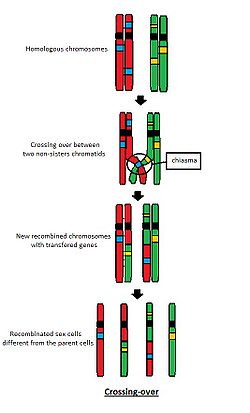Crossing-over
Crossing-over is the process by which homologous chromosomes exchange segments with each other. It occurs most often during the first meiotic division. When prometaphase begins, each chromosome has been duplicated to form two identical sister chromatids. Crossing-over takes place between homologous pairs of chromosomes, with sister chromatids of each homolog swapping segments at various places along the length of the chromosome. Crossing over also occurs between sister chromatids, but because they are genetically identical, such crossing over will not result in genetic recombination.
The Mechanism of Crossing-over[edit | edit source]
The DNA strands must be broken to exchange their segments. The portions of the chromosome that undergo crossing over contain the same gene loci. Crossing-over leads to the recombination of the genes on the chromosomes. The point of crossover is visible as a cross-shaped chiasma.
The exchange is usually reciprocal – the exchanging segments of the two chromosomes are of similar size--, but crossing over can sometimes be unequal. Crossing over can occur at several locations between a synapsing pair of homologous chromosomes. Crossing-over may be:
- single crossing-over;
- double crossing-over;
- multiple crossing-over.
There are several influences that can affect crossing-over:
- age;
- the external influences – chemical, physical, radiations;
- sex.
The Importance of Crossing-over[edit | edit source]
The importance of crossing-over is in the generation of genetic diversity in the resulting gametes. New, genetically recombined sex cells are created. This leads to variation among offspring. Any given genetic combination can be advantageous or disadvantageous, but genetic variability of offspring increases the likelihood that at least some of the offspring will survive in an ever-changing environment.
The frequency of crossing-over between two gene loci depends on the distance between the linked genes. Linked genes are those located on the same chromosome. Unless crossing over occurs between them, the linked genes are transferred together every time meiosis occurs. If crossing-over occurs between linked genes, alleles that are usually inherited together can be recombined and passed on separately in two different sex cells. The likelihood of crossing over between two gene loci can be used to construct gene maps.
Links[edit | edit source]
Related articles[edit | edit source]
External links[edit | edit source]
Bibliography[edit | edit source]
- ALBERTS,, et al. Základy buněčné biologie. 2.edice edition. 2007. ISBN 80-902906-2-0.

